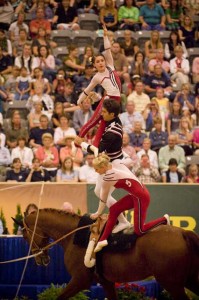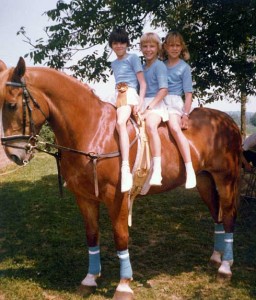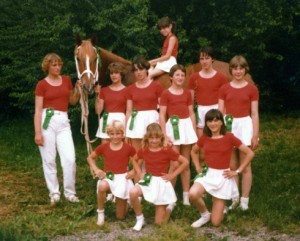Springing Back Into Vaulting
By Bree Krebel March 7, 2012We all have friends or students who have “rediscovered” riding in midlife. Well, I’ve ridden all my life, but at 39 decided to return to the discipline I loved as a child growing up in Southern Germany: vaulting.
For anyone not familiar with vaulting ― on whom the weight of that decision might be lost ― know that it is a sport populated by extremely flexible teen and pre-teen gymnasts who can flip and twirl on the back of a moving horse. The challenges for a thirtysomething vaulter are not insignificant, but part of my goal as a trainer was to develop a program that would enable any level of rider to use vaulting exercises to hone their balance, comfort with the horse and overall riding skills.
I began vaulting at age six and because of my tiny physique became the team “flyer.” A flyer is the smallest member of the team of six vaulters. Flying high through the air as the horse moved below me at a canter, I relied on timing and reflexes to keep my bearings. It was thrilling! I loved the teamwork and feeling the rhythm of the horse. I was crazy about the vaulting shoes, which look like ballet slippers. I loved them so much I often wore them to bed and slept in them!
At about age 14 my family moved to a new town where I began competing in dressage and show jumping. Even in those disciplines, I benefited greatly from all the years of vaulting because my muscles were trained to maintain balance no matter what the horse was doing beneath me. I could ride anything that bucked, reared or jumped ― straight or crooked ― sometimes without stirrups. I won just about every bareback jumping class I entered. It set me up perfectly for the next stage in my equestrian career, starting young horses, which I did in Germany, Great Britain, Philadelphia and Los Angeles, where I relocated in 2003.
That year, I started a non-profit organization called Horse One-to-One Outreach Foundation, Inc. (HOOF). One of our programs, the “Experience Horse Program” for at-risk children, brought vaulting back into my life. I had forgotten about the magic of vaulting and how much I missed it. Seeing the kids’ smiles as they crawled all over the horses’ backs and the trust that existed once again sparked my passion for vaulting.
Vaulting is always a team effort ― at a minimum there is a lunger, who cues the horse using a lungeline and whip, and an individual vaulter. At the higher levels there can be as many as three performers at a time engaged in elaborately choreographed routines set to music. The equipment is simple – USEF, FEI and American Vaulting Association regulations permit a variety of snaffle bits and side reins.
Tack also includes a vaulting surcingle (preferably with wither and girth padding). It has two grips at the top, and on each side, a “Cossack strap” that helps with balance on some of the moves, and also serves as a foot grip. A surcingle pad, made with special, high-density foam, absorbs the vaulters’ movements – swings and jumps – and provides a platform for the performers.
Like so many competitive equestrian sports, vaulting is rooted in the military ― some people believe it originated as a teaching exercise used by the Romans and historical leaders including Alexander the Great. Others claim it has its roots in the bull dancing practiced in ancient Greece. In either case, people have been performing acrobatic and dance-like movements on the backs of moving horses for more than 2,000 years.
In 2008 I saw advertising for the upcoming 2010 Alltech World Equestrian Games at the Kentucky Horse Park in Lexington that inspired me to move there. I volunteered to be an assistant steward for the qualifiers for vaulting and at the games and started a vaulting club called the Bluegrass Vaulting Academy.

Devon Maitozo (center) of the Woodside-based Free Artists Creative vaulting troupe. (Photo by Shannon Brinkman)
Since I am also a hands-on trainer, I began taking vaulting lessons, marking a return to the sport after more than two decades. Just prior to the games I invited Devon Maitozo, of Free Artists Creative Equestrians in Woodside, CA, to teach a clinic for my students. Devon has represented the United States in international competition many times, both as an individual and on teams. He and his team would go on to win the Gold medal for the U.S. at the 2010 WEG. It was during this clinic that I did my first handstand in 27 years!
With that sense of accomplishment came the realization that getting back to competition-level condition was going to be much harder than I thought. My 39-year-old legs were like wet noodles, and I could only hold the handstand for a second before toppling.
I started on a regimen of stretching and fitness. One of my biggest challenges as a returning vaulter was regaining body awareness. Returning to Los Angeles after WEG, I signed up for lessons with Rick Hawthorne, coach of the Valley View Vaulters in Sunland, CA, and (not being one to do things in half-measures) set my sights on the 2011 U.S. National Vaulting Championships, scheduled for August in Denver, CO.
After four months of lessons I felt my body slowly returning to form ― or as much form as one can have as a mature adult in a sport where the superstars are in their teens and twenties. I had to re-learn even the simplest things ― the proper way to point my toes, move my shoulders, hands and arms ― inch by inch, all in the name of proper vaulting, balance and posture.
As I became more fit, I was able to execute my moves more smoothly and hold my poses longer, though it seemed I would never regain the effortless balance I had as a youngster. Despite the fact that I could not walk for several days after each lesson, I found vaulting once again to be addictive.
I learned I would have to compete on a borrowed horse, not the one I had been training on. That is not uncommon in the world of vaulting, but it heightened the challenge. I needed a horse that was not too tall, so I would be able to mount (in vaulting, you mount the horse at a run while it is moving in the designated gait per class ― walk, trot or canter). The ideal vaulting horse has a large, broad back and is smooth and steady in its gait. Temperamentally, they should be of gentle character, and they must be geldings or mares ― stallions are not permitted. Draft crosses, Warmbloods, Belgian, Percheron and Haflinger breeds have all found success in competitive vaulting.
I selected a horse named Ted from the Riding Academy in Menifee, CA. Ted was a 17- year-old, 15.2 hand Belgian/Morgan cross and a veteran vaulting mount. I arrived at Nationals and met the horse, his trainer and lunger the morning I was to vault with time for only one practice round. As I started on him, I realized his gaits were much bouncier than I had expected. My adrenaline was pumping as I dismounted, touching the ground just as the gate steward called for us.
“Oh boy,” I thought, “This is going to be rough!” I was shaking, and it was time to do my compulsories for the judge. I was competing in the Preliminary Trot Individual Compulsories that are comprised of the mount, basic seat, half mill, swing rearways, flag, stand, swing with open legs and swing dismount. Thankfully my years of competition paid off and I was able to turn off my nerves and turn on my concentration for show time.
I gave it everything I had, and all went well until I got to the stand when Ted broke his trot exactly as I rose to the standing position. Slowing to a fast walk then accelerating back to a trot again, I was thrown forward but did not fall off. It couldn’t have looked pretty, though, and I continued my routine, ending with an average score. I did not get a ribbon since my class was filled with the many flexible wunderkinds, but there was a definite satisfaction in having made it through and a thrill as the many wonderful vaulting memories of my youth came flooding back.
I have developed a new program, “Vaulting for Equestrians,” built around carefully selected entry-level exercises that can teach riders to improve their overall performance. My mission for 2012 is to roll-out the program to any barn interested in starting a club.
At the recent Pomona Horse Expo I did a clinic that involved identifying vaulting prospects at random, right there at the show, and engaging those suitable in vaulting exercises with riders who were new to the sport.
The idea was to show that just as any rider can benefit from the postures and discipline of the sport, there are horses in any barn that can adapt to vaulting. Flexibility, balance and poise are skills that are beneficial to riders of all disciplines, and the excitement of stretching outside one’s comfort zone, well, that doesn’t hurt either!
For more information on vaulting, starting a vaulting club or evaluating your horse as a vaulting prospect, visit www.vaultingacademy.com.
Short URL: https://theequestriannews.com/?p=8355





